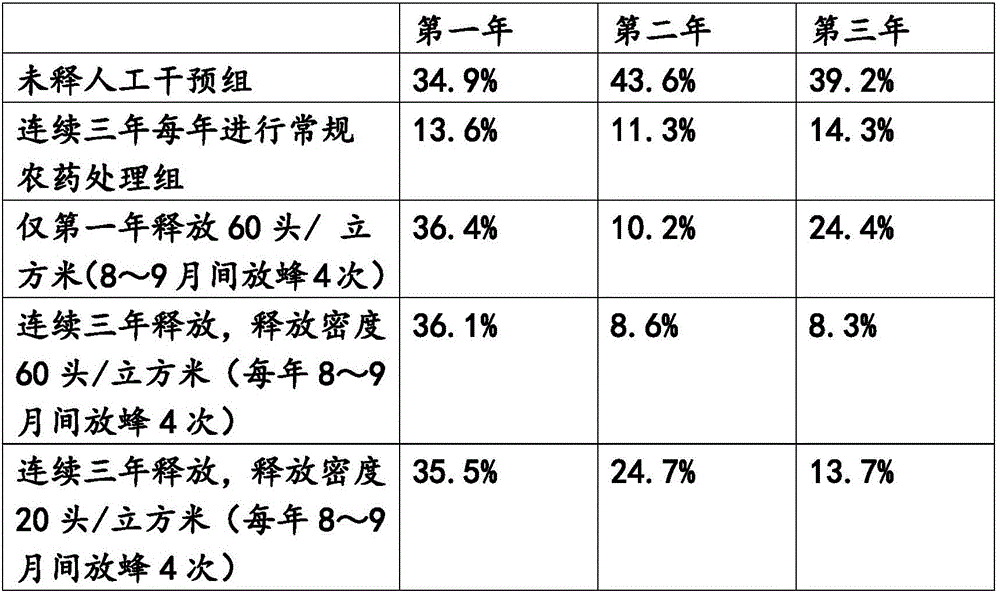Method for preventing and controlling chestnut weevils with scleroderma guani
A technology of swollen-legged wasp and chestnut, which is applied in application, hunting equipment, animal husbandry, etc., can solve the problems of immature parasitoid-type biological control methods and no detection of swollen-legged wasp chestnut weevil parasitism, etc., to reduce The effect of population size and harm rate reduction
- Summary
- Abstract
- Description
- Claims
- Application Information
AI Technical Summary
Problems solved by technology
Method used
Image
Examples
Embodiment 1
[0016] Example 1: The refrigerated old and mature swollen leg cocoons were resuscitated and developed for 72 hours under a constant temperature light box at 18°C and 200lux, and placed on the chestnut trunk at 1m from the canopy at 8 o'clock in the morning, with a density of 60 heads / m3. A small amount of Sclerotus guaniensis was seen to emerge naturally around 3 o'clock in the afternoon, and more than 95% of the cocoons had emerged into bees around 10 o'clock the next day. The release was repeated again on the 7th day after release. Released for three consecutive years. This embodiment effectively reduces the amount of damage of the chestnut weevil.
Embodiment 2
[0017] Example 2: The refrigerated old-frozen swollen leg cocoons were resuscitated and developed in a constant temperature light box at 30°C and 200lux for 48 hours. They were placed on the chestnut trunk at 1m from the canopy at 8 o'clock in the morning, with a density of 20 heads / m3. A small amount of Sclerotus guaniensis was seen to emerge naturally around 3 o'clock in the afternoon, and more than 95% of the cocoons had emerged into bees around 10 o'clock the next day. The release was repeated again on the 8th day after release. Released for two consecutive years. This embodiment effectively reduces the amount of damage of the chestnut weevil.
Embodiment 3
[0018] Example 3: The refrigerated old-frozen swollen leg cocoons were resuscitated and developed in a constant temperature light box at 18°C and 500lux for 48 hours, and placed on the chestnut trunk 3m from the canopy at 8 o'clock in the morning, with a density of 60 heads / m3. A small amount of Sclerotus guaniensis was seen to emerge naturally around 3 o'clock in the afternoon, and more than 95% of the cocoons had emerged into bees around 10 o'clock the next day. The release was repeated again on the 6th day after release. Released for three consecutive years. This embodiment effectively reduces the amount of damage of the chestnut weevil.
PUM
 Login to View More
Login to View More Abstract
Description
Claims
Application Information
 Login to View More
Login to View More - R&D
- Intellectual Property
- Life Sciences
- Materials
- Tech Scout
- Unparalleled Data Quality
- Higher Quality Content
- 60% Fewer Hallucinations
Browse by: Latest US Patents, China's latest patents, Technical Efficacy Thesaurus, Application Domain, Technology Topic, Popular Technical Reports.
© 2025 PatSnap. All rights reserved.Legal|Privacy policy|Modern Slavery Act Transparency Statement|Sitemap|About US| Contact US: help@patsnap.com

